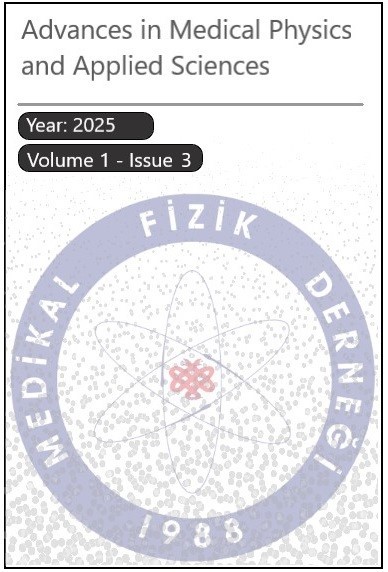A Dosimetrist Performance Analysis on the Dosimetry of 177Lu-DOTATATE Radionuclide Treatment
DOI:
https://doi.org/10.63187/ampas.38Keywords:
177Lu, Dosimetry, Dosimetrist Performans, Radionuclide TreatmentAbstract
The accuracy of the PRRT dosimetric procedure depends on the dosimetrist's personal skills in the step of determining the accumulated activity in the relevant organ. The detection of activity involvement is done manually by the dosimetrist using a mouse on SPECT images. Creating custom ROIs may create differences in dosimetric calculations. The purpose of this study is to investigate the effect of Dosimetrist performans on critical organ dose calculations in PRRT.
To assess the biodistribution of the radiopharmaceutical and calculate organ-specific activity, serial SPECT/CT imaging was performed at 4, 24, 48, and 96 hours post-administration. Bu using SPECT images, VOIs counts were separately determined by using ROIs on the relevant organ created by 3 independent Dosimetrist. Statistical tests were applied to the counts to determine whether there was a significant difference between the counts detected by the 3 independent dosimetrists. The ANOVA test is an analysis of variance method used to determine whether there is a statistically significant difference between the means of three or more groups. In the Anova test, if p < 0.05, there is a statistically significant difference between the groups. If p ≥ 0.05, there is no significant difference between the groups, the observed differences may be due to chance criteria were taken into account. We conducted a statistical evaluation (ANOVA Test) between the counts determined by three different dosimetrists, and no significant difference was observed between their results.
References
-Strosberg J, Wolin E, Chasen B, et al. Health-related quality of life in patients with progressive midgut neuro endocrine tumors treated with Lu-DOTATATE in the phase III NETTER-1 trial. J Clin Oncol 2018;36:2578-2584.
-Ramonaheng K, Qebetu M, Ndlovu H, Swanepoel, et al. Activity quantification and dosimetry in radiopharmaceutical therapy with reference to 177Lutetium. Front. Nucl. Med., Sec. Dosimetry and Radiation Safety 2024, 4: 1355912.
-Kovan B, Özkan Z G, Demir B, et al. An Analysis for Therapeutic Doses of Patients with Neuroendocrine Tumor Treated with Lutetium-177-DOTATATE. Cancer Biotherapy & Radiopharmaceuticals 2022; 37(1): 17-22.
-Mora-Ramirez E, Santoro L, Cassol E et al. Comparison of commercial dosimetric software platforms in patients treated with 177 Lu-DOTATATE for peptide receptor radionuclide therapy. Med Phys. 2020 ; 47(9):4602-4615.
-Kovan B, Demir B, Işık EG, et al. An anthropomorphic body phantom for the determination of calibration factor in radionuclide treatment dosimetry. Radiation Protection Dosimetry, 2023: 199(12); 1274-1283.
-Sandstro¨m M, Garske-Roma´n U, Granberg D, et al. In dividualized dosimetry of kidney and bone marrow in pa tients undergoing 177 Lu-DOTA-octreotate treatment. J Nucl Med 2013;54:33-41.
-Zanzonico P. The MIRD Schema for Radiopharmaceutical Dosimetry: A Review. Journal of Nuclear Medicine Technology June 2024, 52 (2) 74-85.
-Gillespie T, Swinson A, Fu Y, et al. Impact of Post-Therapy Imaging and Dosimetry on Patient Management in Radionuclide Therapy: A Case Study Review. Journal of Nuclear Medicine June 2025; 66 (supplement 1): 25140.
-Vergnaud L, Dewaraja Y K., Giraudet A L, Badel J N, Sarrut D. A review of 177Lu dosimetry workflows: how to reduce the imaging workloads? EJNMMI Physics 2024;11: 65.
-Kratochwil C, Fendler W P, Eiber M et al. EANM procedure guidelines for radionuclide therapy with 177Lu-labelled PSMA-ligands (177Lu-PSMA-RLT): Eur J Nucl Med Mol Imaging. 2019;46(12):2536-2544.
Downloads
Published
How to Cite
Issue
Section
License
Copyright (c) 2025 Abrar Qasım Mustafa AL RAMADHANI, Bilal KOVAN, Serkan KUYUMCU, Bayram DEMİR

This work is licensed under a Creative Commons Attribution 4.0 International License.




